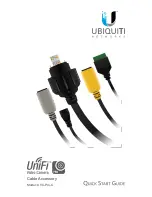
4 | nVent.com
4. Prepare to pull sensing cable into pipe.
1. Insert the curved end of the conduit section into the access
tee down to the level of the primary pipe. Use the conduit to
guide the pull rope and sensing cable into the pipe; position
it to avoid sharp bends, abrasion, and snags.
2. Mount the cable reel onto a payoff stand; insert a piece of
pipe through the reel flange holes and support it with two
chairs or some other appropriate means (see illustration).
The reel must be free to turn.
3. Prepare to Pull from Next Access Point
• Take the second piece of sweep conduit to the next access
point of the containment pipe.
• Identify the correct pull rope. If there is more than one section
of pull rope at this access point, the person to feed cable can
lightly tug the rope from the sensing cable end to identify the
correct rope.
Important: Be careful not to lose the rope into the access point.
It can be time-consuming and expensive to recover a pull rope
lost into the pipe.
If the pull rope has been installed as one continuous length (that
is, looped but not cut at each access tee), it must be cut at the
access tee.
Important: After cutting, secure the end not attached to the
sensing cable.
• At the access point, pass the installed pull rope through the
conduit, curved end first.
• Insert the curved end of the conduit into the access tee down to
the level of the primary pipe. Use the conduit section to guide the
pull rope and sensing cable out of the pipe; position it to avoid
sharp bends, abrasion, and snags.
5. Pull sensing cable into containment pipe.
1. Hold the conduit in position while pulling the cable. Begin
to pull the rope and cable from the second access point.
The person feeding the cable must be able to communicate
problems (such as snags or twisted cable) to the person
pulling, before the sensing cable is subjected to excessive
stress. TT5000 sensing cable must not be pulled with force
greater than 50 pounds or the cable may be damaged.
When installing TT3000 sensing cable, use the ohmmeter on the
payoff reel to monitor the cable condition during pulling. If the
ohmmeter measures a resistance less than 20 MΩ between the
sensing wires, it indicates the sensing cable has encountered water
or contaminant. If this happens, stop pulling at once. Carefully
remove the sensing cable; maintain a light tension on the pull rope
as the cable is pulled out, because the Kellems grip is not designed
for tension in this direction. Dry or clean pipe before reinstalling
sensing cable. Be sure to secure the ends of the pull rope.
2. Finish by pulling the cable through the conduit beyond the
top of the access point riser. Leave at least 12 in (30 mm) of
extra cable for installation of connectors.
Two methods for paying off cable
Conduit prevents
snags and stress to
cable at 90 bends
Access
point
Conduit prevents
snags and stress to
cable at 90 bends
Access
point
0.000
TT3000 sensing cable
To pipe
Secure the
ohmmeter
to the reel
flange
























